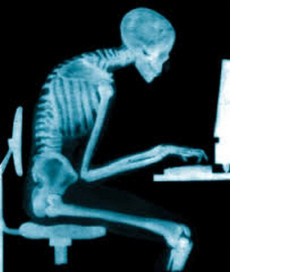
As evidenced by the fact that you’re reading this on a computer or cell phone, it’s fairly obvious that we’re all stuck living our lives with these machines.
Unfortunately, the common posture we find ourselves in while using these devices is hazardous to our health. The posture is what I call the capital “C” position; that is hips flexed to 90 degrees, a rounded spine, forward rolled shoulders, and hyperextended neck. Refer to the picture above if you are a visual person.
I’m sure most people have had the experience of sitting at a desk for a long drive and ended up with back pain. Usually this goes away, but when we repeat this over and over again, the body begins to respond to this position. These responses can include weak and misshaped bones, tight muscles, weak muscles, poor blood circulation, insulin resistance, and high blood pressure. Further more, these responses over time may lead to osteoporosis, osteoarthritis, disc injuries, sprains and strains, brain fog, heart disease, diabetes, and an increased incidence of back pain, neck pain and headaches.
A 2012 article in the American Journal of Clinical Nutrition, authors concluded that time spent in sedentary behaviors is positively associated with an increase in mortality! Washington Post had a terrific poster identifying the various issues associated with sitting.
While I can’t physically make everyone get up and move, I can give you some tips for sitting better.
1. Take micro-breaks
For most people, this means taking a 5 minute break every 20-30 minutes. Or, 10-15 minutes every 2-3 hours of sitting. The key here is to break before you start to feel stiff or sore.
2. Stretch: Brugger Relief Position
During those micro breaks, standing and stretching/moving is the best. However, Brugger’s position of relief can be done while sitting. to do this; Sit at the edge of your chair with your arms hanging at your sides, sitting tall as if you were wearing a crown. Spread your legs apart slightly to the sides, rotate your hands so that the palms face forward and squeeze your shoulders together. Tilt your pelvis forward, lift your breastbone up, and take deep belly breaths for 10 seconds.
3. While sitting at a desk, make sure your desk, chair, and computer are properly positioned. The rule here is 90 degrees. Your ankles, knees, hips, shoulders, and elbows should all be at 90 degree angles, with your feet flat on the floor, and wrists resting lightly on the desk in a neutral position. Your computer screen should be slightly below 90 degrees from your eyes.
You’ll find that you’ll have to practice these tips before they become second nature. Keep in mind, humans are NOT supposed to sit still. We are made for movement.
Until next week,
Dr. Eric O’Connell
